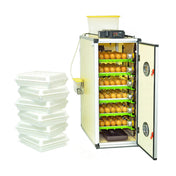Table of Contents
Say goodbye to lugging heavy waterers, refilling waterers constantly, and cleaning algae and dirt from poultry waterers. Automatic waterers are a great way to make your poultry care routine easier, quicker, and more manageable.

Advantages and Types of Automatic Poultry Waterers
There are two main types of automatic poultry waterers: water nipples and water cups. Both types have a reservoir where the water is stored and gravity fed to the nipples or cups. This means that you may only need to refill the reservoir once or twice a week. Situating the reservoir in a shaded area means that clear reservoirs won't grow algae. Solid colored reservoirs can be situated in full sun, but it is better to situate them in shade.
No one likes hot water on a hot day. Raise automatic waterers to neck height, this will vary by species. Cup waterers need to be placed high enough off the ground that the poultry can easily access them, but not too close to the ground where the poultry can kick dirt into the cups. Automatic water cups fit over poultry nipples. Commercial guidelines recommend one poultry nipple for every eight to ten chickens. I recommend chicken feeders waterers having one poultry nipple for every four to five chickens. It is better to have more water access than less in case one malfunctions.

How to Train Poultry to Use Automatic Waterers
Newly hatched quail, chickens, turkey poults, guinea fowl keets, peafowl, and pheasants should be given regular water dishes to drink from. Keep the automatic chicken waterers filled and at a height the chicks can access. In about a week they will start to use them. Regardless of species, when you are raising poultry and using automatic waterers here is the timeline you should follow for getting them accustomed to them: poultry in brooders get regular waterers and water cups for two weeks.
Poultry in grow out cages get automatic water cups. Poultry in layer/breeder cages get automatic nipple waterers or cup waterers. If you have poultry nipples, click the metal nipple up and down until drops of water emerge. Make sure to do this in front of the poultry. How to get your chickens to adapt to nipple watering? It's simple, just click the metal nipple until water emerges, take a drop of water on your finger, and put it on the bird's beak. You really only need to train one bird to use the automatic waterer and the others will follow suit. I strongly recommend transitioning poultry to automatic waterers during mild weather.

Practical Considerations
If your poultry are having issues using the automatic waterers, remember that not all poultry should be drinking from nipple waterers. Nipple waterers are not suitable for pigeons and doves. When pigeons and doves drink they use their beaks as a straw to suck up water. Cup waterers can work for pigeons and doves if they are trained to fill the cup.
Automatic nipple and cup waterers are not suitable for ducks and geese. Ducks and geese need to submerge their nares (the nostril-like openings on their bills) when drinking. This cleans the nares and helps the birds swallow their food. An appropriate waterer for ducks and geese is two to four inches deep and wide enough for them to fully submerge their nares. To keep your automatic waterer from freezing in the winter, a recirculating system will keep the water moving at all times. This will prevent it from freezing. A heater will keep the main supply of water liquid. To keep the water in the hoses from freezing, recirculate the water in the system or wrap the hoses with heat tape.

Maintaining Automatic Waterers
Make sure that all water nipples and cups are functional and working properly. Jammed, leaky, or stuck water nipples will leave your flock with inadequate hydration. Inadequate hydration leads to dehydration, stress, and lower egg production. A heat wave is not the time to put poultry on automatic waterers. Check the water level of your reservoir often, just because there's water in the pipes/hoses does not mean that the reservoir has enough water. If your water nipples leak, check to make sure they are tightened fully. Water cups may leak if the clicker gets flipped up or gets stuck in the down position. Use a turkey baster to drain automatic water cups that overfill. A wet environment poses multiple risks to your poultry. Daily inspection of your poultry is a must in animal husbandry. If you have more than 20 chickens in a coop, consider getting a silo waterer. Silo drinkers come equipped with automatic waterers and a large reservoir. This means you may only have to refill your waterer once a week or every other week.
Hatching Time - Shop everything you need to raise happy, healthy birds!
Written by:

Aryeh Wiesel








